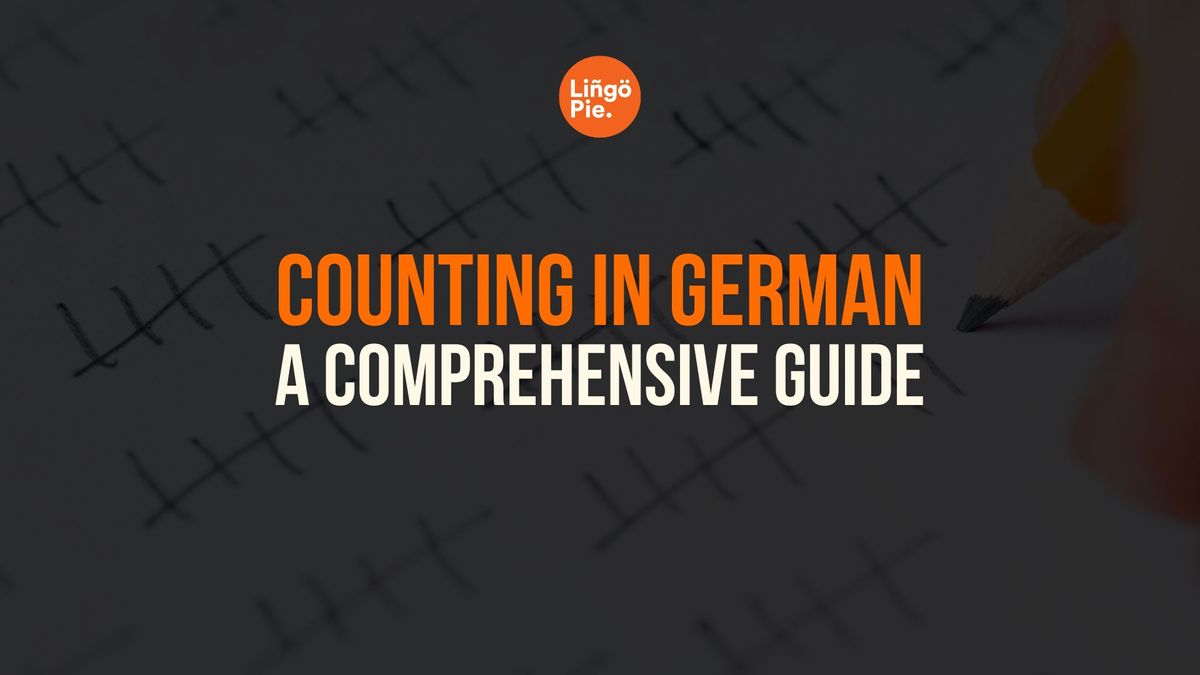Wondering how to count in German? I can't blame you! When you begin to learn a new language, mastering the numbers of that language (as well as basic vocabulary with which to use them, of course) is the best place to start.
Learning German numbers is easy compared to many other languages. This is because the German number system is generally regular; German numbers follow a set pattern. This means that once you know the basic rules, you'll be able to count from 0-1,000+ in German with ease.
In this post, we will discuss German cardinal numbers, with examples of how to use them in daily conversations.
We'll also take a brief look at ordinal numbers, number patterns, and German pronunciation, providing you with useful tips on how to remember German numbers in the process.

Counting in German: Cardinal Numbers in the German Language
Before we start with the numbers 1-10, it is important to remember that there are two different number systems in German: Cardinal and Ordinal system.
The cardinal system is used for counting objects. The ordinal system, which is used for ranking things in order or describing sequences. For example, if you wanted to say "first place" in German, you would use the ordinal number "erste(r/s)" rather than the cardinal number "eins."
How to Count from 0-10 in German
So, let's start with German numbers 1-10, shall we?
- 0 = null (null)
- 1 = eins (eyns)
- 2 = zwei (tsvey)
- 3 = drei (dry)
- 4 = vier (feer)
- 5 = fünf (fuhnf)
- 6 = sechs (zex)
- 7 = sieben (zeebin)
- 8 = acht (akt)
- 9 = neun (noin)
- 10 = zehn (tsayn)
Some examples of when you may find yourself using these numbers in daily conversation are:
- Ich nehme bitte eins Wein und zwei Bier (I'll have one wine and two beers please)
- Zwei und zwei zusammen ist vier! (Two and two together is four!)
- Sind es zwei oder drei Euro für das Bier? (Is it two euros or three for the beer?)
- Ich brauche bitte vier Orangen. (I need four oranges)
Teenage Numbers in German: notice the same pattern?
So, let's move on to teenage numbers in German. Remember that 10 in German is zehn; it will make learning the teens much easier.
- 11 = elf (alev)
- 12 = zwölf (tsvulef)
- 13 = dreizehn (dry-tsayn)
- 14 = vierzehn (feer-tsayn)
- 15 = fünfzehn (fuhnf-tsayn)
- 16 = sechzehn (zekh-tsayn)
- 17 = siebzehn (zeeb-tsayn)
- 18 = achtzehn (akt-tsayn)
- 19 = neunzehn (noin-tsayn)
From thirteen onwards, you simply add 'zehn' onto the end, just as you would add 'teen' in English.
Thirteen through to nineteen should be relatively easy for you to learn with this simple trick. For elf and zwölf it's just a case of revision!
Examples of the teens in sentences are below:
- Mein Sohn ist elf Jahre alt und drei Monate. (My son is eleven years old and three months.)
- In diesem Gebäude gibt es zwölf Etagen. (There are twelve floors in this building)
- Ist es elf Uhr? (Is the time eleven o'clock?)
Learn German numbers above 20
- 21 = einundzwanzig (ayn-oont-tsvahn-tseeakh)
- 22 = zweiundzwanzig (tsvy-oont-tsvahn-tseeakh)
- 23 = dreiundzwanzig (drih-oont-tsvahn-tseeakh)
- 24 = vierundzwanzig (feer-oont-tsvahn-tseeakh)
- 25 = fünfundzwanzig (fuenf-oont-tsvahn-tseeakh)
- 26 = sechsundzwanzig (zekh-oont-tsvahn-tseeakh)
- 27 = siebenundzwanzig (zeeb-oont-tsvahn-tseeakh)
- 28 = achtundzwanzig (ahkht-oont-tsvahn-tseeakh)
- 29 = neunundzwanzig (noyn-oont-tsvahn-tseeakh)
- 30 = dreiβig (drih-zeef)
In German, you would say 'ein und zwanzig (one and twenty) for twenty-one, or 'zwei und zwanzig' (two and twenty) for twenty-two, just with no rest in between each word.
Don't worry if the writing of these numbers seems a bit overwhelming to learn.
Once you get used to the basics of the rules mentioned, you'll soon be able to write and count to one million, and be speaking eins, zwei, drei, vier... in your sleep!
Examples in context are below:
- Auf diesem Tisch liegen zweiundzwanzig Bücher. (There are twenty-two books on this table.)
- Mein Bruder ist dreiundzwanzig Jahre alt und drei Monate. (My brother is twenty-three years old and three months.)
Multiples of 10 in German
20 = zwanzig (TSVAN-zig)
30 = dreißig (DRY-sig)
40 = vierzig (FEAR-tsig)
50 = fünfzig (FUHNF-tsig)
60 = sechzig (ZEX-tsig)
70 = siebzig (SEEB-tsig)
80 = achtzig (AHKT-sig)
90 = neunzig (NOIN-tsig)
As you will have noticed by now, the vocabulary for numbers in German remains fairly regular even for the multiples.
Between forty and ninety, all of these German numbers are regular and follow a sequence of taking the first four letters of the number between 1-10 and adding 'zig.'
Examples in context are:
- Haben Sie Wechselgeld für einen zwanzig? (Do you have change for a twenty?)
- Ich möchte das Hemd im Stil der siebzig Jahre in blau bitte. (I'll have the 70s style shirt in blue please)
How to Remember German Numbers
Once you know the numbers from 0-10, it's relatively easy to count upwards once you memorize the sequence and follow the basic rules.
The good news is that the rule is the same for English numbers in the pattern it follows. It's just a case of practice and memory!
As we reach the larger more complex numbers, you will see how the numbers remain consistent even into the thousands, and it's just a case of stringing the words altogether to form one big number.
Don't worry if this seems confusing - all will become clear soon enough.

Counting above 100 in German: Number from 100-900
100 = hundert (HOON-dert)
200 = zweihundert (TSVY-hoonderdt)
300 = dreihundert (DRY-hoonderdt)
400 = vierhundert (FEER-hoonderdt)
500 = fünfhundert (FUenf-HOONDert)
600 = sechshundert (ZEX-hoonderdt)
700 = siebenhundert (ZEEB-BEN-hoonderdt)
800 = achthundert (AHKT-hoonderdt)
900 = neunhundert (NOYN-hoonderdt)
Again, this is a fairly easy sequence of numbers to learn.
Each word is just the numbers from 1-9, but with 'hundert' added to the end.
Examples of using the hundreds in German:
- I have 100 dollars. (Ich habe hundert Dollar)
- They have 400 students. (Sie haben vierhundert Schüler)
- Do you have 300 euros, please? (Hast du bitte dreihundert Euro?)
German Numbers: 1,000+
In German, numbers in the thousands follow the same pattern.
- 1000 = tausend (TAU-Zent)
- 2000 = zweitausend (TSVY-tau-zent)
- 3000 = dreitausend (DRY-tau-zent)
- 4000 = vierthausend (FEER-tau-zent)
- 5000 = fünftausend (FUENF-tau-zent)
- 6000 = sechstausend (ZEX-tau-zent)
- 7000 = siebentausend (ZEEB-BEN-tau-zent)
- 8000 = achttausend (AHKT-tau-zent)
- 9000 = neuntausend (NOYN-tau-zent)
- 10000 = zehntausend (TSAYN-tau-zent)
As the numbers get more complex into the thousands, it's just a case of stringing the numbers together as one word.
For example, the number 1,221 in German would be 'eintausendzweihunderteinsundzwanzig.' YIKES! That's a long one.
To translate this in English it quite literally reads as 'one thousand, two hundred, one and twenty.'
Once you're familiar with the order of pronunciation in the thousands, you will soon be able to count to a million in German.
The thousands in German in context
- Dreitausend Meter sind eine lange Strecke. (3000 meters is a long distance)
- Vierthausend Euro sind viel Geld. (4,000 Euros is a lot of money)
- In meinem Dorf leben zweitausend Menschen (2,000 people live in my village)
Ordinal numbers in German
Still with us? Super. So, now you're familiar with German cardinal numbers, let's introduce you to the German ordinal number system!
The 21st, 22nd, and 23rd are said 'einundzwanzigste', 'zweiundzwanzigste', and 'dreiundzwanzigste.'
Ordinal numbers in German in context:
- Heute ist der dreiundzwanzigste Juli. (Today is the 23rd of July)
- Ich wohne in der fünfundzwanzigste Straße. (I live on the 25th street)
- Das ist das fünfunddreißigste Mal, dass ich dir das heute sage. (It's the 35th time I have had to tell you this today)
Learn German With Lingopie
So, there we have it! You should now feel more confident counting in German, and much more familiar with the German number system.
As you’ll see, whilst the German language isn't easy, learning the number pattern should not take too long.
Luckily, Lingopie is offering a free trial for you to carry on learning German, with the first week completely free!
Why not sign up to a free trial today and develop your path to German fluency?
Auf geht's und viel Glück!










